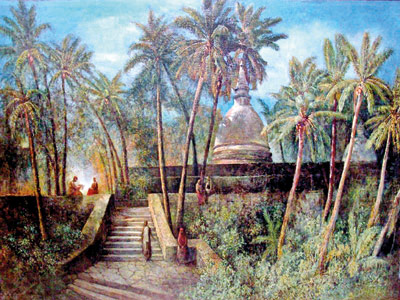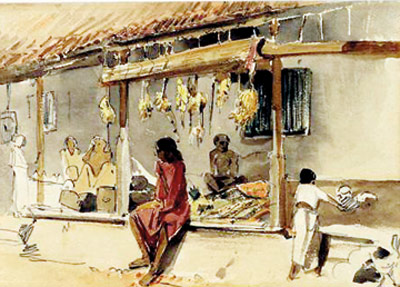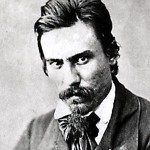19th Century Galle as he saw it
If the visitor to Vienna happens to go to the city’s Museum of Military History he or she will find one gallery dedicated to the expedition of the Novara, the flagship of the Austrian navy in the 19th century.

A Buddhist temple south of Galle
Most non-Austrians will be surprised by the very idea that a mountainous and land-locked country like Austria had a navy at all. But of course until 1918 Vienna was the capital of a vast European empire, which included a coastline on the Adriatic and thus had a navy.
One of the exhibits in the Novara exhibition is a small collection of fine watercolours which includes what are clearly scenes of Sri Lanka.
The story behind these and related paintings is an interesting and little known one.
In 1856 Archduke Ferdinand Max, brother of Emperor Franz Joseph and later to become the ill-fated Emperor of Mexico, conceived the idea of an Austrian ship making a circumnavigation of the globe.
Apparently the initial purpose of the voyage was mainly for the Archduke to travel but as time passed it was understood that it could also have a scientific value as well as be an opportunity to show the Austrian flag. Several other European powers had recently launched such voyages and these had created considerable interest.
The fine three-masted frigate, Novera, had been chosen for the expedition and by 1857 everything was ready. Amongst the many academics and scientists selected to accompany the ship was an artist named Joseph Selleny who enjoyed some popularity in Vienna at the time.
Joseph Selleny had been born in 1824 and studied flower painting and later engraving. In 1842 he took classes in landscape painting under the famous Prof. Kupelwieser.
He had participated in the revolution of 1848 but seems to have rehabilitated himself because six years later he won a prize from the Academy of Fine Arts which allowed him to do further studies in Rome.

A banana kade in Galle market
Selleny is usually thought of as a Biedermeier artist, a style in art, architecture and design characterised by a spirit of sobriety which predominated Austrian art from about 1800 to 1850.
The Novara set sail from Trieste on April 30, 1857 and after stopping at Gibraltar, Rio de Janeiro, Cape Town and some small islands in the Indian Ocean it sailed into Galle harbour on January 8, 1858.
While the captain and other officers were entertained by their British counterparts and some of the crew set off to climb Sri Pada, Selleny went into the town to see the sights and make sketches.
Selleny’s first sight of Galle as the ship sailed into the harbour did not encourage him. He described it as “not very picturesque”.
It should be remembered that at that time Galle was Sri Lanka’s main port and probably looked like any other port Selleny had seen.
But once he got ashore Selleny’s impression of the town changed. His artist’s eye met with numerous strange sights and judging by the number of fine figure studies he did he found the Sinhalese graceful and interesting.
He visited the main market, the fort, several temples and private homes.
Altogether he did 35 paintings, all of them watercolours. Some of these are unfinished. They consist of outlines in pen or pencil with notes on the colours of certain parts.
This suggests that he sometimes came across scenes he wanted to paint, did a quick sketch with the intention of finishing it later but never got around to it.
The paintings that he did finish are quite striking, he successfully captured the quality of the colours highlighted by the tropical air and light.
He also painted a variety of scenes, people and objects which together give a good impression of what life was like in a busy colonial port town. On January 16 the Novara set sail for Madras and finally arrived back at its homeport on August 26, 1859.
The Novara expedition was judged a success and well worth the money spent on it. A three-volume account of the voyage written by Dr. Karl Scherzer and illustrated with some of Selleny’s paintings became something of a bestseller and sold out within a year.
Later it was translated into English and Italian. Such was the public demand for the book that an abridged version came out which eventually went through five editions.
As for Joseph Selleny, he settled down to a career as a modestly successful artist. Later he began to exhibit strange behaviour, eventually went insane and spent the two years before his death in 1875 in an asylum.
A year later a retrospective of 450 of his sketches and 50 of his oil paintings was held in Vienna. A legal battle broke out over the 2000 paintings Selleny had made during the Novara voyage.
The Imperial Navy claimed them all, pointing out that the artist was in its employment during the time the paintings were done.
The heirs claimed some as did various museums and institutions and eventually the collection was broken up. Since then a number of the paintings have disappeared including some done in Sri Lanka, a few were destroyed during the First World War, a small number are in private collections and most of what remains is now kept in the Austrian Collection of the Bellvader (O.G), the Albertina (Al) and the Museum of Military History (H.G.M), all in Vienna.
Joseph Selleny is now almost completely forgotten but the paintings he did in Galle are of interest to Sri Lankans although they have so far not been noticed by Sri Lankan scholars.
Remaining paintings  Joseph Selleny I give a list of the surviving paintings Selleny did in Sri Lanka in the hope that someone more competent than I will examine them more carefully sometime in the future. 1 The Port of Galle. O.G, catalogue number 2256b. Here as elsewhere Selleny always refers to Galle by its old name of Point de Galle. 2 Street life in Galle.H.G.M, MT 2259. 3 A native catamaran. Al, 6547. Selleny says in his journal; “On first seeing these little canoes you cannot but be astonished at the courage and determination of the half naked Sinhalese sailors who dare to sail these little vessels hardly big enough to sit on 30 or 40 miles from the coast.” 4 A boat and figure study. OG, 2257b. 9 A Buddhist abbot and his assistant. O.G, 2257f Selleny commented; “The priests wear a long and wide robe or cape, yellow or white depending on their position within the hierarchy, which is graceful drapery covering the upper part of the body. They shave their heads, go bare footed and carry an umbrella made of talipot in their hands. They are cautious and suspicious towards foreigners.” Here Selleny has clearly mistaken upasakas with monks. Most 19th century Europeans to Sri Lanka found monks curious and friendly. 10 A Sinhalese monk O.G, 2257b. Concerning this portrait Selleny says; “Another temple we visited was the Dadalla Pansala, the biggest in the province and the residence of the chief of the Buddhists. The seventy year old Ven Nyanalankara Sirisumana Mahadhammarajaguru Nyanacariya Nayakawanse surrounded by a retinue of other notable monks who seem to venerate him as if he were a higher being.” 11 Sinhalese of Ceylon. Al, 6550. 19 The gate of the fort in Galle. O G, 2257c. |
Some of them are of historical interest showing as they do how certain locations around Galle appeared towards the end of the 1850s. Others are important in that they give an idea how an European artist saw Sri Lanka and the Sinhalese in the 19th century.


